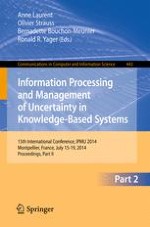These three volumes (CCIS 442, 443, 444) constitute the proceedings of the 15th International Conference on Information Processing and Management of Uncertainty in Knowledge-Based Systems, IPMU 2014, held in Montpellier, France, July 15-19, 2014. The 180 revised full papers presented together with five invited talks were carefully reviewed and selected from numerous submissions. The papers are organized in topical sections on uncertainty and imprecision on the web of data; decision support and uncertainty management in agri-environment; fuzzy implications; clustering; fuzzy measures and integrals; non-classical logics; data analysis; real-world applications; aggregation; probabilistic networks; recommendation systems and social networks; fuzzy systems; fuzzy logic in boolean framework; management of uncertainty in social networks; from different to same, from imitation to analogy; soft computing and sensory analysis; database systems; fuzzy set theory; measurement and sensory information; aggregation; formal methods for vagueness and uncertainty in a many-valued realm; graduality; preferences; uncertainty management in machine learning; philosophy and history of soft computing; soft computing and sensory analysis; similarity analysis; fuzzy logic, formal concept analysis and rough set; intelligent databases and information systems; theory of evidence; aggregation functions; big data - the role of fuzzy methods; imprecise probabilities: from foundations to applications; multinomial logistic regression on Markov chains for crop rotation modelling; intelligent measurement and control for nonlinear systems.
